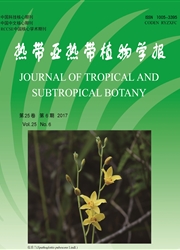

 中文摘要:
中文摘要:
为了解异源多倍体形成后,其剪接因子基因SR30在各组织器官间的表达量以及选择性剪接模式与亲本的差异,选取萝卜-芥蓝异源四倍体(Raphanobrassica)及其亲本萝卜(Raphanus sativus)、芥蓝(Brassica oleracea var.alboglabra)为材料,运用RACE-PCR方法克隆到全长的编码序列(CDS)和3非编码区(3 UTR),运用q RT-PCR和半定量RT-PCR检测其在各组织器官中的表达量和各转录本表达量间的差异。结果表明,四倍体中萝卜同源的Rs SR30基因有5种转录本,芥蓝同源的Bo SR30基因有4种转录本。同时,SR30在3物种中的表达具有组织器官的差异,且在四倍体中的总体表达量显著低于亲本。根据克隆到的转录本,预测Rs SR30编码3种蛋白,Bo SR30编码2种,不同蛋白异构体的区别体现在C末端的丝氨酸-精氨酸富集(RS)结构域。因此,萝卜-芥蓝异源多倍体形成后,SR30基因在表达量和转录本选择性剪接方面都发生了改变。
 英文摘要:
英文摘要:
In order to understand the difference between allopolyploid and its parents in expression level and alternative splicing pattern of SR30 gene when the allopolyploid had been synthesized, different tissues or organs were collected from allotetraploid plant Raphanobrassica and its maternal parent Raphanus sativus, paternal parent Brassica oleracea var. alboglabra. Full-length coding sequence(CDS) and 3 untranslated regions(3 UTR) were cloned by using RACE-PCR. The expression level based on q RT-PCR and relative expression of each m RNA isoforms by using semi-quantitative RT-PCR was detected. The results showed that there were 5 m RNA isoforms of Rs SR30 and 4 m RNA isoforms of Bo SR30 appeared in the allopolyploid. In addition, the expression of SR30 reflected an obvious diversity between different tissues or organs. The expression of SR30 reduced significantly in allopolyploid compared with its parental species. Based on the m RNAs, it was predicted that there are 3 proteins encoded by Rs SR30 and 2 proteins encoded by Bo SR30. The difference between each protein isoforms was reflected in the RS(rich in serine-arginine dipeptides) domains located in C-terminal. Therefore, both of expression and alternative splicing patterns of SR30 changed when the allopolyploid had been synthesized.
 同期刊论文项目
同期刊论文项目
 同项目期刊论文
同项目期刊论文
 期刊信息
期刊信息
